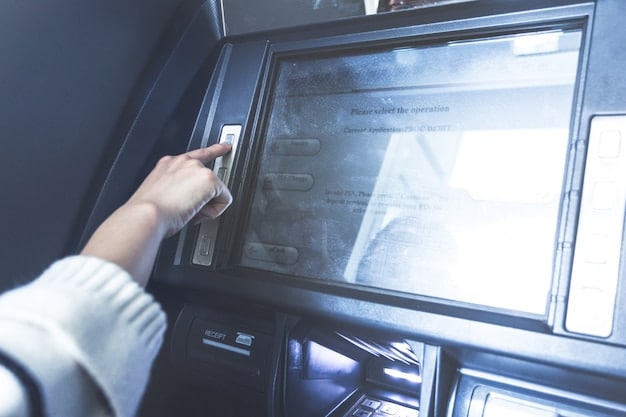Maximize Your Yen: US Tourists’ Guide to Best Exchange Rates in Japan

Maximize Your Yen: Insider Strategies for US Tourists to Get the Best Exchange Rates in Japan This Season focuses on providing US tourists with practical tips and methods to optimize their currency exchange when traveling to Japan, ensuring they get the most value from their dollars.
Planning a trip to Japan? Don’t let unfavorable exchange rates diminish your travel budget. This guide, Maximize Your Yen: Insider Strategies for US Tourists to Get the Best Exchange Rates in Japan This Season, equips you with essential knowledge to secure the best possible rates and make the most of your travel funds.
Understanding Exchange Rates: A US Tourist’s Perspective
When traveling from the US to Japan, understanding how exchange rates work is crucial. These rates fluctuate daily, and even hourly, impacted by economic factors, political events, and market speculation. Knowing the basics helps you anticipate the best times to exchange your funds.
What Influences the USD to JPY Exchange Rate?
Several factors influence the exchange rate between the US Dollar (USD) and the Japanese Yen (JPY). These include economic indicators like GDP growth, inflation rates, and interest rate policies set by the Federal Reserve and the Bank of Japan.
- Economic Stability: A strong US economy typically strengthens the USD against the JPY.
- Interest Rates: Higher interest rates in the US can attract foreign investment, increasing demand for the USD and boosting its value.
- Political Stability: Political uncertainty in either country can lead to volatility in the exchange rate.
Being aware of these factors can give you a better sense of when the exchange rate might be favorable for exchanging your dollars.
In summary, understanding the dynamics between USD and JPY involves keeping an eye on economic indicators and geopolitical events. Armed with this knowledge, you can make informed decisions to maximize your yen during your trip to Japan.
Best Places to Exchange Currency: Comparing Options in the US
Before you embark on your journey to Japan, it’s wise to explore your currency exchange options in the US. Several avenues are available, each with its own set of advantages and disadvantages. Understanding these can help you minimize fees and secure a favorable exchange rate.
Banks and Credit Unions
Your local bank or credit union is a convenient starting point for exchanging currency. They often offer competitive rates to their customers, but it’s important to check in advance as not all branches stock foreign currency.

Currency Exchange Services
Currency exchange services like Travelex are widely available at airports and major cities. While convenient, they typically offer less favorable rates and higher fees compared to banks or online platforms.
Online Currency Exchange Platforms
Online platforms such as Wise (formerly TransferWise) and OFX offer competitive exchange rates and lower fees. They allow you to transfer funds directly into your bank account or receive cash before your trip.
- Convenience: Exchange currency from the comfort of your home.
- Competitive Rates: Often better rates than traditional exchange services.
- Transparency: Clear fees and exchange rates displayed upfront.
Exploring different currency exchange options in the US before your trip can save you time and money. By comparing rates and fees, you can ensure you’re getting the best possible deal before you even set foot in Japan.
Navigating Currency Exchange in Japan: ATMs, Banks, and More
Once you arrive in Japan, you’ll find several options for exchanging currency. Understanding where and how to access Japanese Yen can ensure you have cash on hand for smaller establishments or areas where credit cards aren’t widely accepted.
Using ATMs in Japan
ATMs are a convenient option for withdrawing Yen directly from your US bank account. Look for ATMs that accept international cards, which are commonly found at post offices and convenience stores like 7-Eleven.
When using ATMs, be mindful of potential fees charged by both your bank and the ATM provider. These fees can add up, so it’s wise to withdraw larger amounts less frequently.
Exchanging at Japanese Banks
Major Japanese banks like MUFG and Mizuho offer currency exchange services at their branches. While the rates may be competitive, the process can be time-consuming, and you’ll need to present your passport for identification.

Currency Exchange Counters
You’ll find currency exchange counters at major airports and tourist areas. These are convenient for immediate exchanges, but generally offer less favorable rates compared to banks or ATMs.
- Convenience: Readily available at airports and tourist hubs.
- Accessibility: Easy access for immediate currency needs.
- Potentially Higher Fees: Compare rates before exchanging.
When exchanging currency in Japan, weigh the convenience against the potential costs. ATMs and banks generally offer better rates, but currency exchange counters may be more accessible in certain situations.
Leveraging Credit and Debit Cards Wisely in Japan
While cash is still prevalent in Japan, credit and debit cards are becoming increasingly accepted, especially in major cities and tourist areas. Using your cards wisely can help you avoid excessive fees and secure favorable exchange rates.
Choosing the Right Credit Card
Select a credit card with no foreign transaction fees to avoid extra charges on your purchases. Many travel-centric credit cards offer this benefit, along with reward points and travel insurance.
Informing Your Bank
Before your trip, notify your bank or credit card company that you’ll be traveling to Japan. This prevents your card from being flagged for suspicious activity and ensures smooth transactions.
Understanding Dynamic Currency Conversion (DCC)
Be cautious of Dynamic Currency Conversion (DCC), which allows merchants to charge you in your home currency (USD) instead of JPY. DCC often comes with unfavorable exchange rates and hidden fees.
- Opt for Local Currency: Always choose to pay in JPY when using your credit or debit card.
- Avoid Hidden Fees: Paying in JPY ensures your bank handles the currency conversion, typically at a better rate.
- Transparency: You’ll see the actual exchange rate and any associated fees on your bank statement.
Using credit and debit cards strategically can enhance your financial efficiency during your trip to Japan. By choosing cards with no foreign transaction fees and avoiding DCC, you can enjoy seamless transactions and favorable exchange rates.
Digital Payment Options: Suica, Pasmo, and Contactless Payments
In addition to cash and credit cards, Japan offers various digital payment options that can streamline your transactions and potentially save you money. Understanding these options can help you navigate the payment landscape more efficiently.
Prepaid IC Cards: Suica and Pasmo
Suica and Pasmo cards are rechargeable contactless cards widely used for transportation and purchases at vending machines and convenience stores. They offer a convenient way to pay without handling cash.
These cards can be easily recharged at train stations and convenience stores, making them a practical choice for daily expenses. Some cards also offer discounts on transportation fares.
Contactless Payments: Apple Pay and Google Pay
Contactless payment systems like Apple Pay and Google Pay are gaining popularity in Japan, particularly at major retailers and restaurants. These platforms link to your credit or debit card, allowing for quick and secure transactions.
- Convenience: Quick and easy transactions with a tap of your phone.
- Security: Enhanced security features protect your financial information.
- Wider Acceptance: Increasingly accepted at major retailers and restaurants.
Exploring digital payment options can simplify your financial transactions and enhance your overall travel experience in Japan. Whether you opt for prepaid IC cards or contactless payments, these methods offer a convenient and efficient alternative to traditional payment methods.
Timing Your Exchange: When to Buy Yen for the Best Rates
The timing of your currency exchange can significantly impact the amount of Yen you receive for your US dollars. Monitoring exchange rate trends and understanding seasonal fluctuations can help you make informed decisions.
Tracking Exchange Rate Trends
Monitor the USD to JPY exchange rate over time using financial websites and apps. Look for patterns and trends that may indicate favorable or unfavorable times to exchange your currency.
Considering Seasonal Fluctuations
Exchange rates can be influenced by seasonal events, such as tourist seasons and major holidays. Understanding these patterns can help you anticipate potential fluctuations.
- Off-Season Travel: Exchange rates may be more favorable during off-peak travel times due to lower demand for Yen.
- Holiday Periods: Be mindful of potential fluctuations around major holidays in the US and Japan.
- Economic Events: Watch for major economic announcements that could impact the exchange rate.
Timing your currency exchange strategically can maximize your travel budget and ensure you get the most Yen for your dollars. By tracking exchange rate trends and considering seasonal fluctuations, you can make informed decisions that align with your financial goals.
In conclusion, optimizing your currency exchange involves a combination of understanding exchange rates, choosing the right exchange methods, and timing your transactions strategically. By leveraging these strategies, US tourists can maximize their Yen and enjoy a financially savvy trip to Japan.
| Key Point | Brief Description |
|---|---|
| 💰 Exchange Rates | Understanding and monitoring USD to JPY exchange rates. |
| 🏧 ATMs in Japan | Using ATMs to withdraw Yen with international cards. |
| 💳 Credit Card Use | Leveraging cards with no foreign transaction fees and avoiding DCC. |
| 📱 Digital Payments | Exploring options like Suica, Pasmo, Apple Pay, and Google Pay. |
FAQ: Currency Exchange Tips for Japan
▼
Using ATMs in Japan often provides competitive rates and easy access. Look for ATMs at 7-Eleven or post offices that accept international cards to minimize fees and ensure convenience during your travels.
▼
It can be helpful to have some JPY on hand for immediate expenses upon arrival. Consider exchanging a small amount at your bank or credit union before your trip to cover initial costs.
▼
In major cities and tourist areas, credit cards are increasingly accepted. However, smaller establishments and rural areas may still prefer cash, so it’s wise to carry both options to manage your expenses effectively.
▼
Fees vary by ATM provider and your bank. Your bank may charge a foreign transaction fee, while the ATM provider may also impose a fee, so it’s important to check with both before withdrawing money.
▼
Always choose to pay in JPY instead of USD when using your credit or debit card. Opting for the local currency ensures your bank handles the conversion at a more favorable exchange rate, avoiding hidden fees.
Conclusion
In conclusion, maximizing your Yen as a US tourist in Japan involves strategic planning, informed decisions, and careful execution. By understanding exchange rates, choosing the right exchange methods, and leveraging digital payment options, you can ensure a financially savvy and enjoyable trip. Happy travels!





